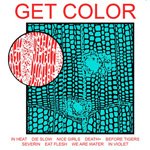Perhaps one of the most startling revelations of 2008 was that the cacophonous maelstrom that made up HEALTH’s self-titled debut sounded awfully good when set to a dance beat. The best remixes off of Disco maintained some of the harshness of the original tracks, but married it to an irresistible, club-ready groove that, in many ways, actually improved upon the source material. Get Color, the band’s proper sophomore release, actively builds on the sonic territory mined by Disco. The guitar squall, the bleached vocals, and the peculiar symmetry are all present, but this time around the end products come out sounding more like actual "songs."
For an example of this more song-oriented approach, one needs look no further than lead single “Die Slow.” It combines a pulsing electronic beat with a scraping, metal-on-metal guitar riff to create the most danceable slab of noise rock this side of Metal Box. Much of the single’s groove owes itself to drummer BJ Miller, who could teach a 16th-century Japanese calligrapher a thing or two about minimalism and restraint here. Indeed, Miller may just be HEALTH’s key ingredient. A versatile musician, he continually pushes each track into surprising sonic territory. The muted tribal thundering of the drums adds both weight and an unexpected sprightliness to the foreboding “Nice Girls,” while his rapid-fire, stop-on-a-dime precision pushes “Severin” to a whole new velocity.
Throughout Get Color, Jake Duzsik’s vocals remain primarily in the background, wraith-like and dispassionate. In most cases, it’s impossible to understand more than a few scattered phrases in any song. Duzsik surrenders his semiotic function as lead singer and allows his voice to become just another element of the song. This decentralization of the vocals is indebted to My Bloody Valentine, just as the relationship between the guitars and the drums owes a great deal to Big Black. More than anything else, however, this album makes me think of Brad Fiedel’s one-man electronic score to Terminator 2. HEALTH’s guitars are drenched in cold, metallic effects, and their melodies are often looming and ominous, but — like the title theme to James Cameron’s action epic — there’s also an element of warmth and humanity that creeps in along the edges. Album closer “In Violet” is a rare quiet moment; the only track from which Miller’s drums are absent, it’s a fragile lament that seems to gesture beyond dissonance and towards something beautiful.
Get Color is exactly what a sophomore release should be: a deepening of and expansion upon the promise laid out by the band’s first record. With this album, HEALTH have established themselves as one of the most consistently engaging of their peers in the L.A. noise rock scene, and perhaps one of the few who will stay with us for the long haul.
1. In Heat
2. Die Slow
3. Nice Girls
4. Death+
5. Before Tigers
6. Severin
7. Eat Flesh
8. We Are Water
9. In Violet
More about: HEALTH




